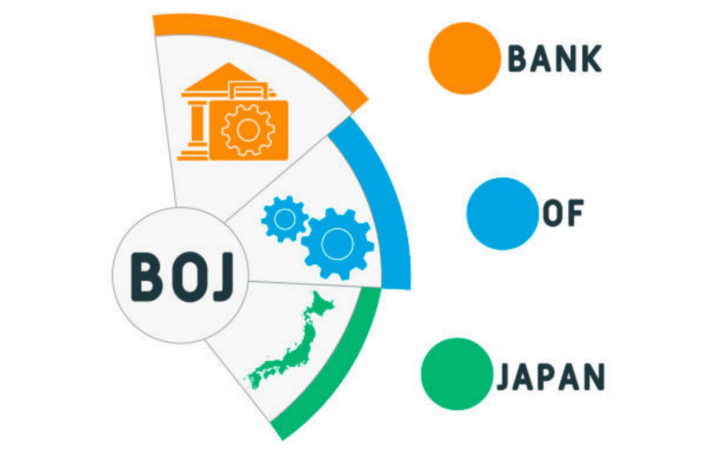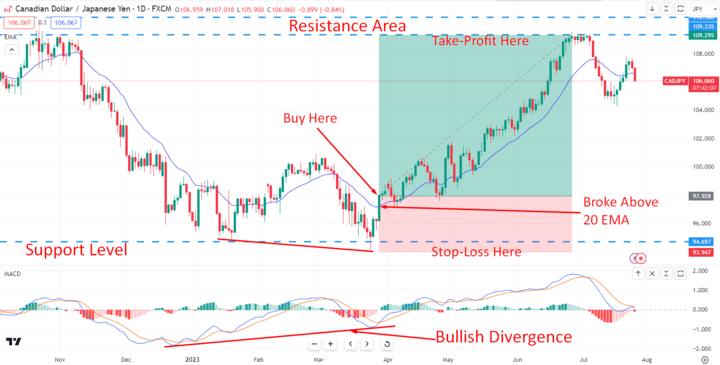Introduction
The CAD/JPY is a popular forex pair, especially among traders interested in the Canadian and Japanese economies. Its value represents how many Japanese yen one Canadian dollar can buy. It reflects the relative strength of these two economies and plays an important role in international trade and financial markets. It provides an excellent opportunity for traders and investors to diversify their trading strategies.
Fundamental analysis is the cornerstone of successful Forex trading. It involves the evaluation of economic, political and social factors that influence the strength of a currency. By analyzing key indicators and events, you can gain insight into potential price movements and make informed trading decisions to manage risk and maximize returns.
Macroeconomic Overview - Canada

Image Source: Unsplash
As you engage in fundamental analysis, keep in mind that the CAD/JPY currency pair is subject to various economic, monetary, and political factors. Understanding these dynamics and staying updated with the latest developments can help you make more informed trading decisions.
A. Economic Indicators Review
In 2022, Canada's gross domestic product (GDP) rebounds strongly, posting a growth rate of 5.7% after the pandemic-induced contraction in 2020. The economy continues to expand in 2023, albeit at a slightly slower pace. Robust GDP growth typically strengthens the CAD. In addition, Canada's unemployment rate declined steadily to 6.8% in 2022 and further to 6.1% in 2023, indicating improved economic conditions and contributing to the strength of the CAD.
Inflation in Canada experienced a temporary spike in 2022, largely influenced by supply chain disruptions and pent-up demand. However, inflationary pressures began to moderate in 2023, with the Bank of Canada closely monitoring the situation. Sustained inflation is a critical aspect of the central bank's monetary policy, which can affect the CAD/JPY.
In addition, high levels of business and consumer confidence support economic growth. In 2022, Canadian businesses showed optimism, which led to increased investment and improved economic activity. This trend will continue into 2023, supporting the CAD.
B. Monetary Policy

Image Source: Unsplash
The Bank of Canada plays a central role in Canada's monetary policy. In response to the economic recovery, the central bank began gradually tightening its monetary policy stance in 2022 and continued to do so in 2023. This included raising policy rates to control inflation and maintain financial stability.
In addition, higher interest rates can attract foreign investors seeking better returns on their investments. As the Bank of Canada implemented rate hikes, it supported the attractiveness of the CAD for investors, potentially strengthening the currency against the JPY.
C. Political Climate

Image Source: Unsplash
Government economic policies can have a significant impact on the value of the CAD. The Canadian government's commitment to fiscal prudence and investment in key sectors has contributed to economic growth in 2022 and 2023.
In addition, Canada is a major exporter of commodities such as oil, metals and agricultural products. Fluctuations in commodity prices can affect the performance of the CAD, as they contribute significantly to the country's export revenues and overall economic health.
Macroeconomic Overview - Japan

Image Source: Unsplash
As you continue your fundamental analysis of the CAD/JPY currency pair, it's crucial to examine the macroeconomic factors that influence the Japanese yen (JPY). These factors play a significant role in shaping the exchange rate dynamics between CAD and JPY and can provide valuable insights for your trading decisions.
A. Economic Indicators Review
In 2022, Japan's economy showed signs of recovery, with gross domestic product (GDP) growing by 2.8%. However, the pace of growth remained modest due to the lingering effects of the pandemic. The economy continued to expand in 2023, with GDP growth projected at 1.9%. Despite these improvements, Japan's unemployment rate remained relatively high, hovering around 2.8% in both 2022 and 2023. A high unemployment rate can dampen consumer spending and weigh on the JPY's performance.
Japan has long struggled with low inflation rates. In 2022, inflation will remain subdued at 0.6% and this trend will continue in 2023. The Bank of Japan has implemented various measures to combat deflation and achieve a sustainable inflation target of 2%. Sustained low inflation can influence the central bank's monetary policy and affect the value of the JPY.
Throughout 2022 and 2023, Japanese businesses and consumers were cautiously optimistic. While sentiment improved with the economic recovery, geopolitical uncertainties and domestic challenges posed some headwinds. Confidence plays an important role in determining investment and spending patterns, which can influence the JPY's performance.
B. Monetary Policy

Image Source: Unsplash
The Bank of Japan continued its accommodative monetary policy to support economic growth and combat deflation. The central bank continued its asset purchase program and maintained ultra-low interest rates in both 2022 and 2023. The Bank of Japan's monetary policy stance may affect the JPY's attractiveness to investors.
On the other hand, expectations of interest rate changes can have a significant impact on the exchange rate. Despite the global economic recovery, the Bank of Japan has signaled its commitment to keeping interest rates low in the near term. Interest rate differentials between Canada and Japan can affect the CAD/JPY.
C. Political Climate
The Japanese government has implemented various economic policies to stimulate growth, address demographic challenges, and promote innovation. These policies aimed to revitalize the economy and create a favorable business environment for investors.
However, Japan's aging population and declining birth rate present unique economic challenges. The changing demographic landscape may influence consumer behavior, labor markets, and overall economic growth, potentially affecting the JPY's performance.
Analysis of the CAD/JPY Currency Pair

Image Source: Unsplash
The fundamental analysis of the CAD/JPY currency pair requires the examination of relevant economic indicators and factors that influence the Canadian Dollar (CAD) and the Japanese Yen (JPY). Understanding these dynamics will help you take an informed stance and make informed trading decisions.
A. Relevant Economic Indicators

Image Source: Unsplash
The CAD/JPY cross is influenced by the correlation between the Canadian and Japanese economies. In 2022 and 2023, both countries experienced economic recoveries, but at different paces. While Canada's economy rebounded robustly with positive GDP growth rates, Japan's growth remained moderate due to challenges related to the pandemic and demographic shifts. Understanding the interplay between these economies can provide insight into potential currency movements.
GDP growth, inflation rates, and interest rates have a significant impact on the CAD/JPY. Higher GDP growth in Canada can strengthen the CAD, while low inflation rates in Japan can influence the JPY. In addition, interest rate differentials between the Bank of Canada and the Bank of Japan may attract or discourage foreign investors, affecting the currency pair.
B. Factors Supporting a Bullish or Bearish Stance

Image Source: Unsplash
The Bank of Canada's monetary policy decisions have a profound effect on the CAD/JPY cross. Tightening monetary policy, such as raising interest rates, can strengthen the Canadian dollar, signaling a bullish trend. Conversely, easing monetary policy can weaken the CAD, indicating a bearish trend.
Similarly, the Bank of Japan's monetary policy decisions affect the CAD/JPY. Expansionary policies in Japan, such as quantitative easing, can lead to a weaker yen, which supports a bullish outlook for the CAD/JPY pair. Conversely, any tightening measures could signal a bearish trend.
As a major commodity exporter, Canada's economy is heavily influenced by fluctuations in global commodity prices. Rising commodity prices can boost the Canadian dollar and support a bullish stance for the CAD/JPY pair. On the other hand, falling commodity prices can lead to a bearish outlook.
C. Potential Risks to the Currency Pair

Image Source: Unsplash
Economic shocks, such as unexpected changes in global economic growth, can cause significant volatility in currency markets. A downturn in the global economy could negatively affect both the Canadian and Japanese currencies, leading to increased risks for the CAD/JPY pair.
Unexpected shifts in monetary policy by central banks can create uncertainty in the currency market. Any sudden changes in interest rates or unconventional measures could cause rapid movements in the CAD/JPY exchange rate, posing risks for traders.
Geopolitical events and trade tensions can also have an impact on the CAD/JPY. As Canada and Japan have significant trading relationships with the U.S. and China, any disputes or trade disruptions could affect their currencies and pose risks for investors.
Trading Strategies for CAD/JPY

Image Source: Unsplash
Employing various trading strategies that combine both fundamental and technical analysis is fruitful. Implement technical analysis using indicators such as moving averages and MACD to identify trends and patterns. Practice risk management by setting appropriate stop-loss and take-profit levels and determining position size based on risk tolerance. In addition, stay abreast of economic events and data releases and trade based on the market's reaction to the news.
A. Technical Analysis
Technical analysis is the study of historical price charts to identify trends and patterns that may repeat themselves in the future. By identifying trends, such as uptrends, downtrends or sideways movements, you can make more informed trading decisions. Use charting tools and techniques to identify support and resistance levels, trend lines, and chart patterns such as head and shoulders or double tops/bottoms.

Image Source: Tradingview
Technical indicators can offer valuable insights into market trends and momentum. Two widely used indicators for CAD/JPY trading are moving averages and the Moving Average Convergence Divergence (MACD) oscillator. Moving averages smooth out price fluctuations, highlighting trend directions, while the MACD measures the relationship between two moving averages to signal potential trend reversals.
B. Risk Management
Risk management in trading is critical to preserving capital and avoiding significant losses. Effective risk management helps traders maintain discipline, protect their accounts, and achieve long-term sustainability in the markets.
Risk management is critical in forex trading. Set appropriate stop-loss orders to limit potential losses should the trade move against you. Similarly, set take-profit levels to secure profits when the trade reaches your desired target. Properly placed stop-loss and take-profit orders can help you maintain discipline and protect your capital.
Calculate your position size based on your risk tolerance and the distance between your entry and stop-loss levels. Avoid overexposing your trading account by risking more than a small percentage of your capital on any single trade.
C. News Trading

Image Source: Unsplash
Stay tuned for important economic events and data releases in both Canada and Japan. Events such as interest rate decisions, GDP reports, and employment data can have a significant impact on the CAD/JPY currency pair. Use economic calendars to plan your trades around these important announcements.
When trading the news, pay attention to market sentiment and the currency pair's reaction to the released data. Volatility often increases during news events, creating both opportunities and risks. Always exercise caution and use appropriate risk management strategies when trading news.
Speaking of trading strategies, VSTAR is a powerful trading platform that provides real-time data and analysis to help you make informed decisions. Use the platform's advanced tools and features to execute your trading strategies with precision and efficiency.


You can develop a well-rounded approach to trading the CAD/JPY currency pair by combining fundamental analysis, technical analysis and risk management techniques. Remember to stay abreast of the latest economic developments and market trends as this knowledge will enhance your ability to adapt to changing market conditions. Use the tools and resources provided by VSTAR to enhance your trading experience and improve your overall trading performance.
Conclusion
The fundamental analysis of the CAD/JPY currency pair provides valuable insights for forex traders looking to make informed decisions. Throughout 2022 and 2023, the Canadian economy showed strong signs of recovery, as evidenced by a robust GDP growth rate and a declining unemployment rate. In contrast, Japan's economic growth remained modest and inflation rates remained low. The monetary policies of the Bank of Canada and the Bank of Japan were key drivers of the performance of the CAD and JPY, respectively.
Combining fundamental analysis with technical analysis, risk management and news trading can help traders develop effective strategies for trading the CAD/JPY currency pair. Leveraging VSTAR's real-time data and advanced tools can further enhance your trading experience and help you successfully navigate the dynamic forex market.


















